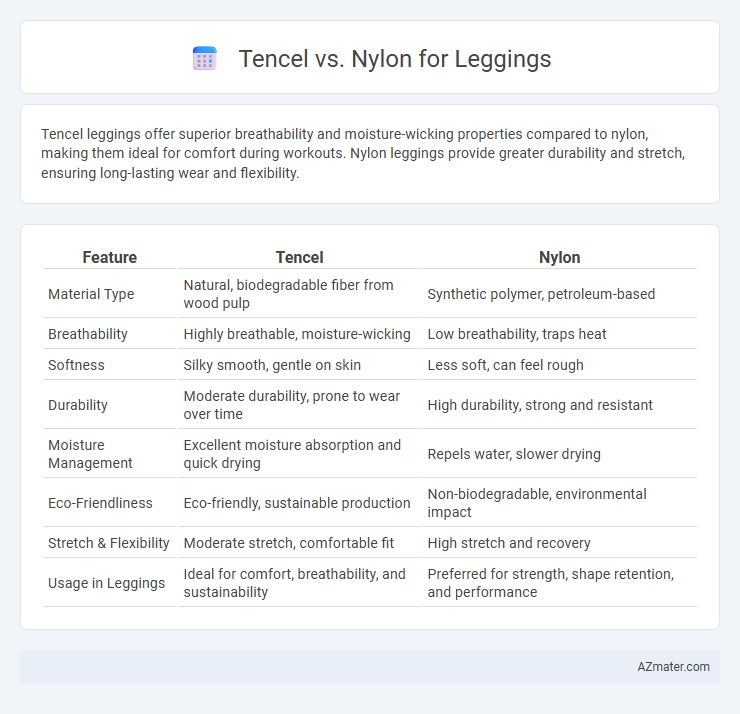Tencel leggings offer superior breathability and moisture-wicking properties compared to nylon, making them ideal for comfort during workouts. Nylon leggings provide greater durability and stretch, ensuring long-lasting wear and flexibility.
Table of Comparison
| Feature | Tencel | Nylon |
|---|---|---|
| Material Type | Natural, biodegradable fiber from wood pulp | Synthetic polymer, petroleum-based |
| Breathability | Highly breathable, moisture-wicking | Low breathability, traps heat |
| Softness | Silky smooth, gentle on skin | Less soft, can feel rough |
| Durability | Moderate durability, prone to wear over time | High durability, strong and resistant |
| Moisture Management | Excellent moisture absorption and quick drying | Repels water, slower drying |
| Eco-Friendliness | Eco-friendly, sustainable production | Non-biodegradable, environmental impact |
| Stretch & Flexibility | Moderate stretch, comfortable fit | High stretch and recovery |
| Usage in Leggings | Ideal for comfort, breathability, and sustainability | Preferred for strength, shape retention, and performance |
Introduction to Tencel and Nylon Leggings
Tencel leggings are made from sustainably sourced wood pulp, offering exceptional breathability, moisture-wicking properties, and a soft, silky feel ideal for sensitive skin. Nylon leggings, crafted from synthetic polymers, provide superior durability, elasticity, and abrasion resistance, making them popular for high-performance athletic wear. Both materials cater to different needs: Tencel prioritizes eco-friendliness and comfort, while nylon excels in strength and stretch for active lifestyles.
Material Origins: What Are Tencel and Nylon?
Tencel is a sustainable fabric made from wood pulp, primarily sourced from eucalyptus trees, using an eco-friendly closed-loop process that minimizes environmental impact. Nylon, on the other hand, is a synthetic polymer derived from petroleum-based chemicals through a complex petrochemical manufacturing process. Understanding the natural, renewable origins of Tencel versus the fossil fuel dependency in nylon production highlights key differences in their environmental footprints and sustainability profiles for leggings.
Sustainability: Tencel vs Nylon Environmental Impact
Tencel leggings outperform nylon in sustainability due to Tencel's eco-friendly production process that uses sustainably sourced wood and a closed-loop system minimizing water and chemical waste. Nylon manufacturing relies heavily on non-renewable petroleum resources and produces significant greenhouse gas emissions and pollutant runoff. Choosing Tencel reduces environmental impact by promoting biodegradability and lower carbon footprint in legging materials.
Comfort and Feel: Which Fabric Is Softer?
Tencel offers exceptional softness due to its natural cellulose fibers, providing a smooth, breathable feel that enhances comfort during extended wear. Nylon, while durable and elastic, tends to be less soft and can sometimes cause a less breathable and slightly synthetic texture against the skin. For leggings prioritizing softness and moisture-wicking, Tencel outperforms nylon by delivering a gentle, cooling touch that supports sensitive skin.
Moisture-Wicking and Breathability
Tencel leggings excel in moisture-wicking and breathability due to their natural cellulose fibers, which absorb moisture efficiently and allow air circulation, keeping the skin dry and cool during workouts. Nylon leggings, while offering strong durability and stretch, tend to trap heat and moisture, making them less breathable compared to Tencel fabrics. For activewear focused on moisture management and ventilation, Tencel provides superior comfort and temperature regulation.
Durability and Longevity Comparison
Tencel leggings offer moderate durability with excellent moisture-wicking and breathability, making them ideal for everyday wear but less resistant to abrasion compared to nylon. Nylon leggings excel in durability and longevity, providing superior resistance to tearing and stretching, which makes them suitable for high-intensity workouts and frequent use. The balance between Tencel's eco-friendly softness and nylon's robust performance determines the best choice based on user needs for durability and lifespan.
Stretch and Flexibility: Performance for Active Wear
Tencel offers exceptional breathability and moisture-wicking properties but has moderate stretch and flexibility, making it ideal for low-impact activities. Nylon is highly elastic and resilient, providing superior stretch and recovery, which enhances performance in high-intensity activewear like leggings. Combining Tencel with nylon blends can optimize comfort, flexibility, and durability for versatile workout leggings.
Maintenance and Care Instructions
Tencel leggings require gentle washing in cold water and air drying to preserve their moisture-wicking and breathable properties, while avoiding bleach and fabric softeners to maintain fabric integrity. Nylon leggings are more durable and can be machine washed in cold or warm water, but should be tumble-dried on low heat or air-dried to prevent damage and loss of elasticity. Both materials benefit from washing inside out and avoiding high heat to extend the lifespan and retain vibrant colors.
Price Differences and Value for Money
Tencel leggings generally come with a higher price tag due to their sustainable production and natural breathability, offering superior moisture-wicking and softness compared to nylon. Nylon leggings tend to be more affordable and durable, making them a cost-effective choice for everyday wear and intense workouts. Evaluating value for money depends on prioritizing eco-friendly comfort with Tencel or budget-friendly versatility with nylon.
Final Verdict: Which Legging Material Is Better?
Tencel leggings offer superior breathability, moisture-wicking properties, and sustainability, making them ideal for eco-conscious consumers seeking comfort and performance. Nylon leggings excel in durability, elasticity, and resistance to wear, providing a long-lasting fit ideal for intense workouts and frequent use. The better material depends on personal priorities: choose Tencel for softness and environmental benefits, or nylon for strength and stretch.

Infographic: Tencel vs Nylon for Legging
 azmater.com
azmater.com